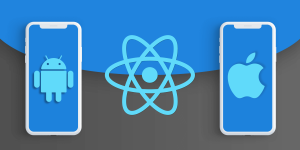 React Native; what is it, why is it useful and why does it have a promising future for hybrid mobile app development services? These are three primary questions, which we need to know before developing our first hybrid application.
React Native; what is it, why is it useful and why does it have a promising future for hybrid mobile app development services? These are three primary questions, which we need to know before developing our first hybrid application.
React Native is nothing but a simple framework designed with a cross-platform ideology. With this, developers can create cross-platform apps using JavaScript. The formula is simple – create an application suitable for both platforms, iOS and Android, written in JavaScript, with native features. It means that the application will have a look, feel, and performance of a native one. It is done by transforming these features into JavaScript, making these applications perfectly functional and genuinely native.
Before proceeding further, let us discuss what a hybrid application is.
What is the idea behind the hybrid application?
There are currently two dominant operating systems when it comes to mobile devices: iOS and Android. Each OS has a type of platform for the development, storage, and commercialization of applications. It poses a great challenge for developers who are dedicated to mobile and want to serve both audiences. In this scenario, making it possible for a single project to be accessible to both iPhone and Android users was quite challenging.
Recently, a new type of software is gaining a lot of space – hybrid applications. It allows a program to be distributed on multiple mobile platforms, with only one development stage. As we know, necessity is the mother of invention. Here, the need was to develop a software, which offers a single platform that builds apps for all mobile users, whether Android or iOS, and the design was “REACT NATIVE”. With the help of the software, we can now execute a single project for both iOS and Android, the ultimate platform for a hybrid application.
Why REACT NATIVE is an emerging trend in 2020?
React Native is an open-source JavaScript library created by Facebook to develop user interfaces through components. which is the main factor for its emergence in 2020. Let us see its benefits:
- The first significant advantage is striking; the opportunity for portability.
- Native apps have a professional look, and their performance is considerably better.
- Web App development simplifies programming by using the same common platform.
- With React Native and its hybrid approach, it is possible to develop an app with native performance but with the benefits of web development.
- Another feature that this platform offers is the Hot Reload.
- The React Native API gives us access to a large number of native functionalities.
Virtual DOM
The main advantage of React Native is to be able to generate the Document Object Model. It is a structure of the elements that are generated in the web browser when loading a page dynamically. This feature improves the user experience when browsing the web application, the speed of loading the pages and makes it easier to maintain the application. It provides excellent readability and versatility to the code, which facilitates the development of the software.
Wide community
Based on JavaScript, it has a broad community that has a large number of external libraries. The web applications developed with React are based on reusable components. It makes the application more scalable and easier to maintain. It also eases generating mobile applications using the same JavaScript code as the web application and its development facilities such as flexibility, speed and organization of the code make it one of the favorite options.
Cost reduced by 50% with React Native
Generally, when we work with native apps, we need to hire two teams of developers, one for Android and one for iOS. This not only doubles the cost, but also the time required for development. React Native development solves this problem, as it allows you to generate both applications, using the same source code. It enables a single team of professionals to create applications on both platforms. One of the great benefits of React Native applications is that you only need a JavaScript developer to create and maintain applications on both platforms.
No manual updates: post updates faster
Choosing React Native allows developers to generate independent versions of iOS and Android with a single configuration file. Once your app has been published, chances are you want to improve it with new features for your users. But, it is a time-consuming process once it is published. Therefore, updated applications must be manually installed by users. The advantage of React Native is that you can develop and publish updates for your applications faster through direct updates.
Design time cut in half
React Native Application Development is the methodology that allows you to create applications that work on both Android and iOS from the same code base. By using hybrid development, the development time is cut in half, as stated earlier. It allows us to create both applications (Android and iOS) simultaneously.
According to research, 60% of the cost of a project comes from maintenance carried out after development. This maintenance includes the addition of new features, bug fixes, and software improvements. React Native development allows you to create code or functionality and use it to implement updates to both applications (Android and iOS). By reducing the time to develop improvements in half, one does not need to create specific code for each platform. This same process also lowers maintenance costs by 50%, as it is possible to use only one team to develop an improvement.
Conclusion
But, why is React Native emerging? It is because it has a bright future in cross-platform app development. It has a mature community, and it has support from Facebook. So, be sure, and hire the best Mobile App Development Company now.
Agile app development, excellent user experience, and advanced programming: React Native offers us enough features to be amazed. Hybrid application development comes as a solution to reduce the cost and time of creating applications. The other reasons for its success are that it supports iOS and Android from the start, monitoring the entire development system, saves time when creating production builds, etc. which makes it possible to create more agile, economical, and easy maintenance solutions for your organization.














